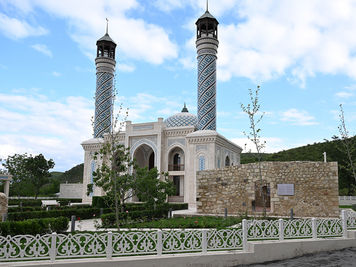

ADALAT MAMMADOV
PRESERVE
Zangilan Mosque
Adalat Mammadov, under the “preserve” theme, is highlighting his design for Zangilan Mosque, a monumental restoration project that blends traditional Karabakh architectural elements with modern design. The mosque symbolises the fusion of past and present, preserving religious heritage while reflecting the community's resilience and determination. Through this project, he demonstrates how architecture can restore cultural landmarks and strengthen communal bonds while respecting the natural beauty of the surrounding landscape.

Adalat Mammadov (Barda, 1959) graduated in architecture from the Azerbaijan University of Architecture and Construction. Since 1980, he has held key roles, including chief architect at the “Azerbarpa” Research and Design Institute. His works span mosques, museums, and restoration projects, notably the House Museum of Uzeyir Hajibeyli, Heydar Mosque, Shamakhi Mosque, Taza Pir Mosque, Zangilan Mosque, and many others. He has also led major conservation efforts, including the Shah Abbas Caravanserai and Imamzadeh Complex. Recognized for his contributions to historical preservation, he holds UNESCO and ICOMOS certificates and was named Honoured Architect of Azerbaijan in 2018.

The Resilient Spirit of Zangilan
Zangilan Mosque
Located in the southern part of Karabakh, Zangilan is one of the most breathtaking sites in Azerbaijan, almost a living work of art, with its lush forests, flowing rivers and important architectural monuments. Due to the 30 years of occupation that prevailed in the region, many of the monuments were either totally or partially destroyed. Even though the destruction of landmarks, including mosques, aimed to erase our people’s heritage, their spirit never faded. On the contrary, it motivated them to rediscover their “intelligens” and pursue their goals with even greater passion. This restoration effort is part of a larger project revitalizing the liberated territories of Karabakh. Significant resources have been dedicated to preserving cultural heritage and rebuilding sustainable infrastructure, with the goal of healing the scars from the long conflict.


Preservıng the Heritage
Zangilan Mosque
Zangilan’s natural beauty calls people to embrace it and create something worthy of it. The mosque represents a synthesis of the past and the present. It was built next to the ancient mosque, which was demolished during the occupation. This new mosque embodies the traditional design specific to the Karabakh region, while incorporating elements of modern architecture.
What makes the Zangilan Mosque even more remarkable is that, despite its vibrant colour, it blends seamlessly with its natural surroundings. Surrounded by green landscapes, the mosque's structure complements the natural environment, reflecting a deep respect for the land’s beauty and serenity. The design makes the mosque appear as though emerging organically from the very landscape it occupies, with nature and architecture coexisting in perfect harmony.
The new mosque is rectangular in form, with two minarets and three dome towers. There are two prayer rooms, one accommodating 220 people and the other 100 people. The minarets and domes are of glazed tiles and bricks. The interior decoration features vegetal motifs on the mihrab, crafted on glazed tiles. The pulpit and other decorative elements are of wood.
It is worth noting that the mosque not only preserves the religious heritage but also symbolizes the “intelligens” of the new community, which honours its past while looking towards the future. It serves as a gathering place that fosters social connection, enhancing the community's civic life. It is a place where people reflect on their history, remembering the hardships faced by both society and nature. It represents everything that was destroyed – from a single tree once planted, to the homes in which memories were made with loved ones. Thanks to their collective will, they have returned to their homeland to rebuild and revive.











